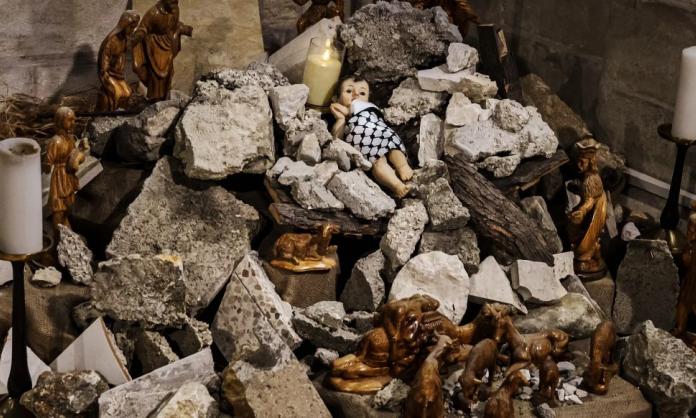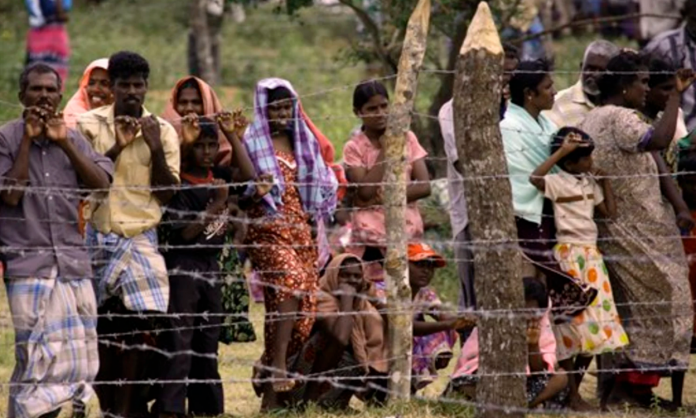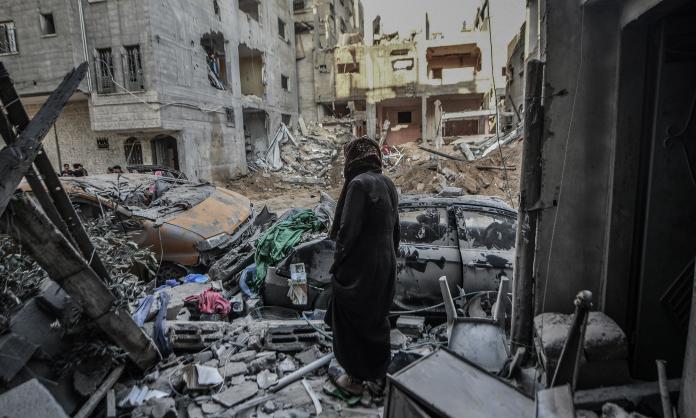“The Australian Government continues to work with the United States and other partners in support of the international rules-based order in the Middle East and surrounding region.”
—Defence Minister Richard Marles
In Gaza, 378,000 people are in a state of famine due to Israel’s siege. A new UN report spells it out, just in case anyone needs the meaning of “famine” explained: “Starvation, death, destitution and extremely critical acute malnutrition levels are evident”. Another 939,000 people are estimated to be in a food “emergency”.
The report’s estimates refer to the situation on 7 December. Nearly three weeks later, the situation is worse. No doubt much worse.
“At most, people have one litre of water per day—that’s for drinking, washing and cooking”, says a public statement issued on 18 December by Ricardo Martinez, the logistics director of the medical aid group Medecins Sans Frontiers (Doctors Without Borders or MSF), who has just spent four weeks in Gaza.
One litre.
Per day.
At most.
Average household water use in Melbourne is one hundred and sixty four times that amount.
Israel has worked on this project for years: Bombing Gaza’s desalination plants, blockading parts needed to keep them working, destroying pumps used for sewerage or water, extracting massive amounts of groundwater and, now, preventing enough fuel to run any remaining desalination plants.
Meanwhile, in some obscene alternate reality, Richard Marles, the defence minister in Australia’s Labor government, tweets about Australia’s commitment to the “international rules-based order in the Middle East”.
Marles was referring to the government’s commitment to Operation Prosperity Guardian, a US-led naval expedition to ensure the smooth flow of international trade in the Red Sea in response to recent armed attacks on Israeli shipping.
Yep. A flotilla of heavily armed battleships can be rapidly assembled to protect oil tankers and container ships vital to world trade. But Australia, the US and their allies claim to be incapable of dropping a single package of food or water to assist the people of Gaza.
This is nothing new. As Perry Anderson recently documented in New Left Review, modern “international law” can trace its origin back to the 1530s, as a legal rationale for the Spanish empire’s brutal campaigns of conquest, plunder and enslavement in the Americas. Every empire since has evolved some version of this “rules-based order”, in which the rules are rewritten to suit whichever force is imposing the “order”.
This year’s model leaves Israel free to use starvation and thirst as a weapon of war without fear of repercussions. Trade routes stay open, money continues to be made, and bought-and-sold servants of empire such as Richard Marles and the rest of the Labor Party get to crap on about the glories of the “international rules-based order”.
Along with hunger and thirst, and the substantial diplomatic and military cover provided by the US and its allies, a crucial element of Israel’s military campaign is the catastrophic aerial bombardment. The destruction unleashed on Gaza matches or surpasses the most brutal bombing campaigns of World War Two and the decades since. At least 20,000 are dead, with many more buried and decaying under the rubble.
Australia’s weapons industry is making an active and profitable contribution to this slaughter.
Research by Melbourne’s Renegade Activists details some of the local contributions to the F-35 fighter-bombers that are raining death on Gaza. For instance, the “uplock actuator system”, which opens and closes the bomb bay doors on F-35 planes, are manufactured in suburban Bayswater, in Melbourne’s east. Every time a family is wiped out or a child maimed for life by a bomb dropped by an F-35, it’s a crime made in Australia as well as in Israel and the US.
To complete the list of Israel’s main methods of war, we must include the deliberate and methodical destruction of Gaza’s health system.
“I saw tanks and snipers at the top of the buildings… They started opening fire on us, and when a bullet grazed my forehead, I got a superficial injury. The bullet hit my colleague Alaa in the head.”
—An MSF staff member recounting an attack by Israeli soldiers on clearly marked MSF cars in Gaza in November 2023. Two people, including a nurse who volunteered with the organisation, were killed in the attack.
“My heart dropped. It was unimaginable – a hospital bombed directly. I looked out the window. Suddenly, the courtyard was full of dust. You could hear screams echoing everywhere. And the alarm barely stopped.”
—Soher, a doctor at al-Nasr paediatric hospital, describing Israel’s shelling of the hospital to the Electronic Intifada website in November.
We could pile up hundreds of these testimonies. Thousands.
Since mid-December, Israel has launched a surge of attacks on the surviving hospitals and healthcare facilities in Gaza. This has included besieging the Palestine Red Crescent Society’s ambulance station at Jabalia refugee camp; firing artillery shells into the maternity ward at the Nasser hospital in Khan Younis; shelling the barely-functional Al-Shifa hospital in Gaza City, which is still being used as a shelter; rolling military bulldozers over Palestinians sheltering at the Kamal Adwan hospital after days of siege, killing at least 8 people; storming the Al-Awda hospital in northern Gaza after besieging and intermittently shelling it for two weeks.
Dr. Ghassan Abu Sittah is a Palestinian-British surgeon who spent 40 days working in Gaza up to late November. He’s worked with MSF in wars all over the region—but he’s never seen anything like this. He told Al-Jazeera:
“What has made this war different to all the other wars I have been at, not just in Gaza but around the region—in Yemen, Iraq and Syria—is the way that the destruction of the health system has been the main thrust of the military strategy.”
Israel’s army has form. It attacked four hospitals in the 2014 attack on Gaza, as detailed by the International Committee of the Red Cross. Israel’s 2021 onslaught also included a ban on medical supplies entering Gaza, and an attack that left the main approaches to al-Shifa (Gaza’s biggest hospital) into an impassable “crater-marked moonscape” according to Britain’s Independent newspaper.
In the West Bank, Israel’s military raids regularly include terror and violence directed at the health infrastructure. On 14 December, a statement from MSF described the actions of Israel’s army in the occupied West Bank town of Jenin:
“Israeli forces just shot and killed an unarmed teenage boy inside Khalil Suleiman hospital compound. Efforts to save his life from MSF and Ministry of Health doctors were in vain ... Paramedics and ambulance drivers were ordered out of the ambulances, stripped and made to kneel in the street. The patients were left in the ambulances.”
As a result, a 36-year-old Palestinian man bled to death.
“The paramedics were screaming and demanding that the wounded be transported immediately, but the soldiers didn’t respond and kept pointing their weapons at the ambulance, preventing it from moving”, journalist Mahmoud Zarkana told the Middle East Eye website.
This is happening every day. So let’s speak plainly.
Hospitals are rightly seen as places of refuge in time of war. Smashing them is a way of smashing society.
And Israel’s aim is exactly the smashing of Palestinian society, as part of Israel’s ongoing project of driving Palestinians out of Palestine. Israel’s aims have always been to grab the land and expel the people. The strategy and tactics of how and when to do that have been debated and adjusted and rolled out at different paces over time.
Demography is obviously key in this project.
In a notorious interview with the Jerusalem Post in 2004, demographer Arnon Soffer recommended pulling Israeli settlements and forces back from Gaza and applying military force from outside the strip instead. Sofer predicted a crisis in the years to come: “When 2.5 million people live in a closed-off Gaza, it’s going to be a human catastrophe ... The pressure at the border will be awful. It’s going to be a terrible war. So, if we want to remain alive, we will have to kill and kill and kill. All day, every day”.
In 2007, Soffer doubled down on these comments, observing with satisfaction that “demographic pressure” in Gaza was now being directed towards Egypt. And now Sofer’s strategy has arrived at the slaughter he predicted. The Israeli army kills and kills and kills in Gaza. All day, every day.
In September, Prime Minister Benjamin Netanyahu waved around a map of “the new Middle East” at the UN, celebrating Israel’s ongoing normalisation of relations with Saudi Arabia. The map has no place for Palestine, and Israel’s new partners in the region seem to have no problem with that.
As the whole world knows, Christmas celebrations are cancelled in Bethlehem this year in solidarity with those living and dying under the bombs in Gaza. But from the start of the year to the finish, Israel’s army has also been spreading its terror in the town of Christ’s birth, as with the rest of the West Bank.
On 3 January, Palestinian media reported that the Israeli army had shot and killed Adam Ayyad, a 15-year-old boy, in a dawn raid on the Dheisheh refugee camp on the outskirts of Bethlehem. Adam was the third Palestinian to be killed in the West Bank this year. That toll is now at least 483.
The most recent raid on Bethlehem seems to have been before dawn on 18 December when Munther Amira was beaten and arrested in the Aida refugee camp just north of Bethlehem’s town centre. A detailed report at US website Mondoweiss notes that Munther Amira “is known all across Palestine for his non-violent activism against the Israeli occupation; he works with the Popular Struggle Coordination Committee, a collection of grassroots activists in the West Bank”. He’s also chair of the board at the local youth centre.
Family members were beaten and terrorised during the raid. When a 14-year-old boy next door shouted for Munther to take care in prison as he was driven away, Israeli soldiers shot at the house.
As of Christmas Eve, Munther is still in jail—one of 4,695 Palestinians arrested in the West Bank since 7 October.
And this is Australia’s ally.
If there is to be any justice for the people of Palestine, it is not to come from the “international rules-based order”.
On the Friday before Christmas, 150 healthcare workers and supporters gather near St Vincent’s hospital in Melbourne. It’s a solemn affair. A list of 340 healthcare workers killed by Israel’s attacks is read out—from nurses to nurses to administrative staff to lab technicians and clinical microbiologists.
There’s a solidarity among healthcare workers worldwide—though it can be difficult to find ways to express it, given the atmosphere of repression regarding speaking about Palestine cultivated by Victoria’s Labor government in public sector workforces including healthcare.
It occurs to me that there is something else at stake for healthcare workers, and the rest of us, in this contest. That is, a society built on human care and solidarity rather than endless arms spending for imperialist war.
A quick Google search turns up cuts to funding in St Vincents Melbourne’s mental health department. This is likely to lead to “a greater number of preventable deaths” according to a protest letter from staff reported in the Guardian. St Vincents in Sydney is on a path to insolvency “within months” due to a funding crisis, according to Rick Morton in the Saturday Paper.
Anyone who relies on public health might ask the question: with much of our healthcare system in semi-permanent rolling crisis, why are we pouring money and expertise into high-tech, fast-acting “uplock actuator systems” for F-35s used to bomb Gaza—or anywhere else that the US empire and its allies feel like bombing? Why are we committed to buying nine of the “attack class” nuclear powered submarines so beloved by Richard Marles at a cost of $368 billion?
It’s because Australia, like Israel, is a key partner in the US military alliance that is preparing for an even more terrifying war with China. Every “great power” is re-arming. The horrors unleashed daily in Palestine foreshadow the horrors they are planning to unleash.
On Christmas Eve, for the eleventh Sunday in a row, many thousands of us march once again through Melbourne’s central business district. The atmosphere is far from festive—but it’s not downbeat either. “Defiant” probably captures it. I walk the length of the rally to get a sense of it. Every section of it is chanting, drumming, shouting: this is no time for silence.
We’ve been part of a global movement without parallel in the long history of solidarity with Palestine. There’s chat everywhere, and no doubt will be in the months to come, about strategy, ongoing protests, next projects, how to focus this extraordinary energy in the most effective ways.
“Mourn for the dead, and fight like hell for the living” was the slogan of legendary US labour movement organiser Mother Jones a century ago.
Many will be praying for the dead this Christmas—in Bethlehem, in Gaza, and around the globe. And in the year to come, we’re going to have to keep fighting like hell for the living—against Israel, against the US, and against Richard Marles’ profit-driven, blood-drenched “international rules-based order”, better described as 21st century capitalism.








